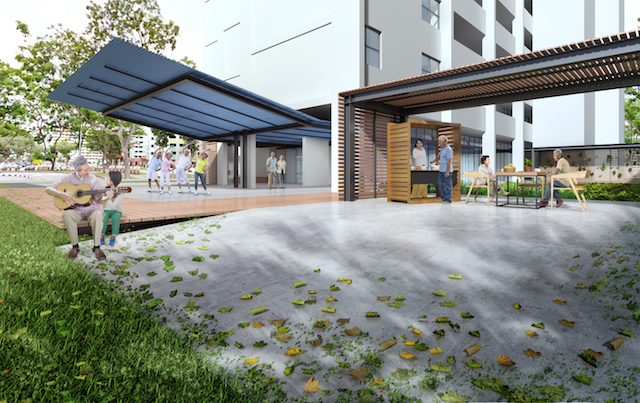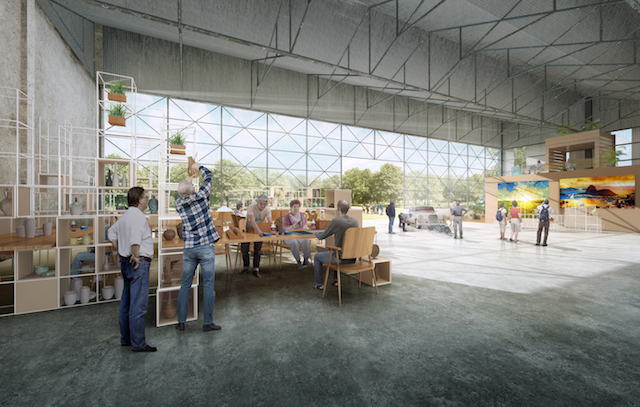Transforming under-used spaces
Lien Foundation and a design firm launches book with 10 ideas that transform under-used spaces into thriving communities for seniors.
A 173-page book on architectural designs that was recently released puts forward new ideas on how unused and under-used spaces in land-scarce Singapore can be re-purposed into thriving communities for seniors to lead active and engaged lives. “Second Beginnings – Senior Living Redefined” proposes 10 new types or “typologies” of spaces to enable seniors to pursue passions, initiate interest-based activities, exercise and, if needed, be cared for within the community.
Nine spaces are building and landscape designs, while one is a retrofitted bus. Each is accompanied by suggestions of a few sites in Singapore where it could be located as well as similar case studies from overseas. The designs in the book are loosely grouped into two categories: Decentralised wellness/lifestyle and care centres, and alternative residential living models such as assisted-living facilities. Most involve re-purposing existing buildings, infrastructure or spaces found in the city and help seniors find new purpose in life.
It was commissioned by Lien Foundation and produced by local design consultancy COLOURS: Collectively Ours. The authors, COLOURS founding partners Dr Chong Keng Hua, an assistant professor at Singapore University of Technology and Design, and Kang Fong Ing, a landscape architect, treat Singapore’s space crunch as an opportunity to spark innovation and to do more with less, rather than an excuse to maintain status quo.

In the ‘Kelong Co-op’, seniors are clustered according to interests, circle of friends, or similar healthcare needs.
For instance, the unused land below raised MRT tracks is transformed into a ‘Viaduct Village’ where seniors can run small businesses such as a café, a hair salon, or even care centres for children. Yet another idea is to convert old warehouses, flatted factories or even the hangar at the old Kallang Airport into a ‘Hobby Factory’ for seniors to pursue passions old and new. While ideas like the ‘Hobby Factory’ and ‘Viaduct Village’ encourage seniors to embrace productive and creative pursuits, others like ‘Giving Campus’ – a hostel where seniors live and learn with university students, expand the mind and forge intergenerational ties. The ‘Healing Stadium’ and ‘Garden of Life’, meanwhile, explore new models of care in communion with nature while the ‘Kelong Co-Op’ offers baby boomers with shared interests, an idyllic retirement community by the waterside.
The Foundation is working with TOUCH Community Services to develop one of the typologies, known as the Community Pocket, in a HDB void deck in Ang Mo Kio. The new facility, which is set to be completed by end of this year, will offer interest-based activities, opportunities for exercise and rehabilitation, health services and, above all, equip them with the skills to help other seniors – especially those who are frailer and more vulnerable – to stay in the community. It will also run Lien Foundation’s Gym Tonic strength training programme for seniors which helps fight frailty. Some parts of the facility will even remain open round the clock.

‘Community Pocket’ is a launch pad to connect residents and create resources to support ageing in the community.
The facility is targetting residents residing in the Ang Mo Kio precinct that covers 32 HDB blocks with a population of 12,000, out of which there are 1,600 individuals who are above 65 years old.
Lien Foundation’s CEO Lee Poh Wah stressed that the task of enabling seniors to age purposefully in the community needs collective effort and should not be left to the Government alone. “This book and the project with TOUCH is part of the Foundation’s efforts to forge a better future for our seniors. We believe that everyone – including property developers, service providers and the seniors themselves – can also do their part to solve the challenges of loneliness, boredom and helplessness many experience in their retirement years,” he said.
Lee added that an age-friendly city is not only one that provides ramps and railings, wide walkways, ample public seating and wheelchair-friendly public transport. It is certainly not one that builds ghettos for the old. Instead, it is one where seniors can co-exist in harmony with people of all ages, feeling welcome and engaged in whatever they choose to do. “Through ‘Second Beginnings’, we wanted to train our lenses on something that is just as important but hasn’t caught the public attention yet – designing physical spaces,” he said. “As Singapore ages rapidly, we hope good design can be used more often to help seniors lead purposeful and happier lives.”
COLOURS Dr Chong, who also runs a research lab focusing on social architecture at SUTD, said: “From our interactions with seniors, we know that they have diverse needs, interests, and aspirations. We have also learnt that most older Singaporeans not only want to age-in-place, but also want to age with familiar people and stay in a familiar community.
“By re-imagining some of the familiar and yet under-used spaces, we hope to offer seniors more diverse social spaces, residences, services, and experiences to choose from. They still have much to give and many things to look forward to in their golden years. These suggested locations are places where they can ‘age-in-community’ and enjoy ‘second beginnings’.”
The new TOUCH facility at Block 433 at Ang Mo Kio Ave 10, modelled after the Community Pocket typology, for instance, is being designed with inputs from more than 200 local residents who took part in the four workshops organised by COLOURS and TOUCH. Many residents wished to age at home and looked forward to exercise opportunities, and health and wellness activities. A separate survey of 500 seniors by TOUCH showed that around eight in 10 knew of an elderly or distressed caregiver in the neighbourhood who needed their help and nearly half expressed interest in becoming a volunteer. The facility will be a part of TOUCH’s Community Enablement Project or CEP, which taps on the organisation’s eldercare expertise to develop residents as community resources, said TOUCH CEO James Tan.
“This new facility will be an activity node, and a launch pad for residents to be engaged, equipped and activated as resources in the community to help seniors age-in-place,” said Tan. “We will provide health coaching and promote healthy habits to improve physical and mental well-being. Residents will also learn useful skills and knowledge, including how to help seniors prevent falls, spot and assist a person with dementia, and diabetes prevention and care management. We will raise awareness about the resources in the community, how they can be accessed and enable residents to be befrienders. These skills will help them become more confident in stepping out to give back to the community.”
(** PHOTO CREDITS: Lien Foundation/COLOURS: Collectively Ours)



0 Comments